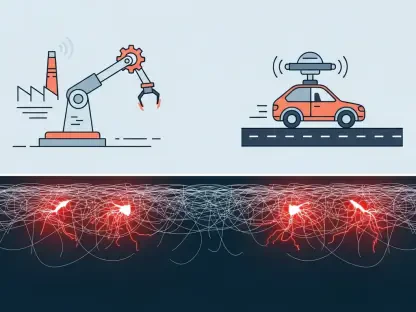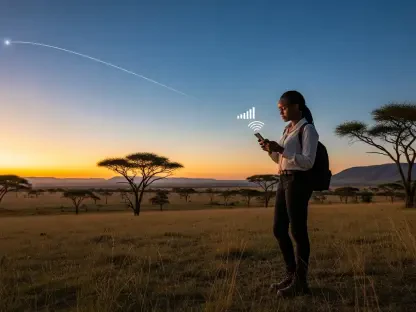What happens when two global tech giants combine their strengths to tackle the digital divide and revolutionize connectivity? At the India Mobile Congress this year, a historic partnership between India and the United Kingdom was unveiled with the launch of the Connectivity and Innovation Centre. Backed by a staggering investment of 2.820 billion Indian rupees (about US$31.7 million) over four years, this alliance promises to reshape telecommunications and artificial intelligence on a global scale. The potential for transformation is immense, sparking intrigue about how this collaboration could bridge gaps and set new benchmarks in innovation.
The Stakes of a Digital Revolution
This partnership arrives at a pivotal moment when digital connectivity is no longer just a luxury but a fundamental driver of economic progress and social equity. With India’s vast rural areas still struggling for reliable internet access and the UK’s advanced tech landscape seeking scalable solutions, the collaboration addresses critical needs on both fronts. Beyond national borders, it sets an example for international cooperation in confronting shared challenges like cybersecurity threats and the race toward 6G technology. The urgency to innovate has never been clearer, as billions worldwide remain disconnected from the digital economy, making this initiative a beacon of hope for inclusivity.
The significance of this alliance extends far beyond technical advancements. It represents a strategic alignment of two nations with complementary strengths—India’s burgeoning tech talent and market potential paired with the UK’s established innovation ecosystem. This synergy could redefine global telecom standards and position both countries as leaders in emerging technologies. The Connectivity and Innovation Centre is not just a project; it’s a bold statement of intent to solve some of the most pressing digital challenges of the current era.
Foundations of a Game-Changing Alliance
At the heart of this collaboration are several key focus areas designed to push the boundaries of what’s possible in AI and telecom. AI-driven network optimization stands out as a priority, aiming to enhance performance and develop cutting-edge services for faster, more reliable connectivity. Non-terrestrial networks (NTN), such as satellite and airborne systems, are another cornerstone, targeting broadband delivery to remote regions and promising a leap in digital inclusivity. These efforts build on a shared vision to ensure no one is left behind in the digital age.
Telecom cybersecurity also takes center stage, with both nations working on open, interoperable solutions to safeguard networks against evolving threats. Joint research on 6G technology further cements their ambition to lead the next wave of connectivity standards. Historical ties, such as the partnership between the UK’s SONIC Labs and India’s C-DOT, provide a solid foundation, while cross-border investments—like Bharti Group’s 24.5% stake in BT and Vodafone Idea’s prominence in India—strengthen economic bonds. These pillars collectively signal a comprehensive approach to innovation that leverages past successes for future gains.
Insights from the Frontlines
Industry experts are already hailing this partnership as a transformative step. A spokesperson from the India Mobile Congress declared, “This Centre is poised to merge academic brilliance with practical, market-ready solutions, setting a new global standard for telecom innovation.” Such optimism is echoed by the UK-India Business Council, which highlights how investments like Airtel’s involvement in BT foster trust and facilitate seamless technology exchange between the two nations. These voices underscore the credibility and high expectations surrounding the initiative.
Real-world impact is already visible through pilot projects deploying NTN systems to bring broadband to rural areas in both countries. These early successes demonstrate the tangible benefits of the collaboration, from connecting isolated communities to empowering local economies with digital tools. Stories of farmers in remote Indian villages accessing market data via satellite networks or small businesses in rural UK gaining online visibility paint a vivid picture of the potential scale of change. Such examples lend weight to the ambitious goals set by this alliance.
Navigating Challenges and Opportunities
While the promise of this partnership is undeniable, hurdles remain in translating vision into reality. Ensuring equitable access to technology across diverse demographics in both nations poses a significant challenge, particularly in India’s vast and varied terrain. Additionally, aligning regulatory frameworks and intellectual property rights between the two countries will require meticulous coordination. Yet, these obstacles also present opportunities to create robust policies that could serve as models for other international collaborations in the tech space.
The investment of over US$31 million signals a serious commitment, but scaling innovations like 6G and AI-driven networks demands sustained funding and stakeholder engagement beyond the initial four years, from 2025 to 2029. Engaging local communities and small enterprises in the deployment process will be crucial to ensure solutions are tailored to real needs. Overcoming these barriers could not only strengthen bilateral ties but also establish a blueprint for global tech partnerships focused on sustainable development.
Strategies to Maximize Impact
For stakeholders eager to engage with this groundbreaking initiative, several practical steps can amplify its reach and effectiveness. Universities and startups in both India and the UK should tap into the Centre’s resources for collaborative AI and telecom research, fostering innovation through shared expertise. Enterprises can play a role by participating in field trials and lab testing, helping turn theoretical advancements into scalable solutions for network optimization or rural connectivity.
Policymakers, on the other hand, should advocate for frameworks that prioritize inclusivity, ensuring NTN technologies reach underserved communities in line with the partnership’s core mission. Companies can also adopt the open security solutions developed through this alliance to protect their networks against emerging cyber threats. These actionable strategies provide a clear path for diverse groups to contribute to and benefit from this evolving tech landscape, ensuring the impact is both broad and enduring.
Reflecting on a Historic Milestone
Looking back, the launch of the Connectivity and Innovation Centre marked a defining moment in the journey of India-UK collaboration. It stood as a testament to what could be achieved when two nations united their expertise and resources to address global digital challenges. The shared commitment to AI, 6G, and cybersecurity reflected a deep understanding of technology’s role in shaping economic and social progress.
As this partnership unfolded, the focus shifted toward actionable next steps. Stakeholders were encouraged to invest in continuous research, prioritize community-driven solutions for rural connectivity, and build resilient cybersecurity frameworks. The path ahead demanded global cooperation to sustain momentum, ensuring that the innovations pioneered by this alliance reached every corner of society. This historic endeavor laid the groundwork for a future where connectivity knew no boundaries, inspiring other nations to follow suit with similar bold initiatives.









